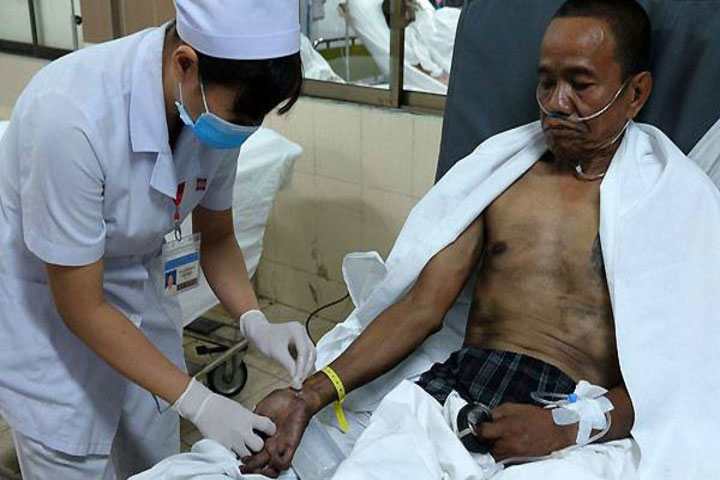How dangerous is a respiratory burn?
When the ambient temperature is too high like a fire, inhaling hot air into your body will damage the airway from your nose to your lungs and burn inside.
Nearly 60 people had to be hospitalized in emergency at Carina Plaza apartment fire (District 8, HCMC). Most victims have severe respiratory burns due to inhalation of dust, but not skin burns.
Dr. Nguyen Nhu Lam, Deputy Director of National Burn Institute explained that respiratory burns are very dangerous and inside the body, it is difficult to observe, difficult to treat, dangerous complications.
When the ambient temperature is too high as in a fire, humans inhale hot air, causing damage to the mucous membranes and airways from the nose to the lungs. The first is respiratory burns that cause edema, discharge in the airway; then the airway is narrowed, the oxygen into the body is lacking, so the more edema, the more likely it will cause the body to be poisoned due to lack of oxygen.
In addition, victims can also be poisoned by gases formed during combustion such as CO and Cyanide, causing death very quickly.

Emergency aid for apartment fire victims with respiratory burns.(Photo: Le Phuong).
Respiratory burns cause three types of injuries: direct damage due to heat, airway necrosis; inhalation of toxic gases, stimulating airway injury, lung damage; CO poisonous gas and Cyanide absorbed from the lungs into the blood.
According to Dr. Lam, patients who suffer from respiratory burns often suffer from serious lung damage, leaving many complications such as respiratory failure. In the early stages, the patient suffers from airway obstruction due to phlegm, because the necrotic mucosa and peeling fall into the airway leading to death. In the late stage, patients with pneumonia, progressive acute respiratory distress syndrome, mortality rate of 80%.
Therefore, patients with respiratory burns should be treated in a timely manner, exposed to fresh air or oxygen immediately to remove CO and Cyanide from the body. The patient was undergoing airway endoscopy to look for foreign bodies, get clogged phlegm, and diagnose the location of burns, the extent of burns to have appropriate treatment regimens.
According to Dr. Nguyen Thong, former Head of the Burn Department, Saint Paul Hospital (Hanoi), the toxic gases generated from the fire are extremely dangerous. In patients hospitalized for inhalation of smoke, doctors often experience cases. This is very toxic to the respiratory and circulatory systems. Lightly, the patient exhibits vomiting, headache, mental disorder; severe coma, cardiovascular collapse, death. Depending on the concentration, the location of the patient, the time to inhale the smoke, the poisoning situation is severe or mild.
Experts recommend that people when inhaling smoke should not be subjective but need to seek medical care because there is a potential risk of pneumonia. Especially when there are signs of coughing, shortness of breath, sputum of black sputum such as soot, headache, nausea, rapid breathing, rapid pulse, they must go to the hospital immediately.
When a fire or smoke occurs, find an exit by going low, close to the floor, not standing tall. Exit to the balcony waiting for people to save or down stairs; Use a wet cloth to cover the nose and mouth to prevent toxins from entering the respiratory tract.
- Detecting mechanism of causing respiratory disease in children
- Successfully prepared vaccines against many respiratory diseases at the same time
- Respiratory problems in children: industrial emissions are more dangerous than traffic emissions
- How is 'dry blindness' dangerous to health?
- The most dangerous MERS virus is now dangerous
- How to prevent respiratory disease during the season
- Things to know about dangerous diseases Mers
- Mold can cause respiratory disease
- Why are babies born on caesarean section more susceptible to respiratory disease than babies born normally?
- Bodhi smoke can fight bird flu
- Deadly respiratory syndrome like SARS spreads rapidly
- Simple way to wash nasal respiratory disease
 Green tea cleans teeth better than mouthwash?
Green tea cleans teeth better than mouthwash? Death kiss: This is why you should not let anyone kiss your baby's lips
Death kiss: This is why you should not let anyone kiss your baby's lips What is salmonellosis?
What is salmonellosis? Caution should be exercised when using aloe vera through eating and drinking
Caution should be exercised when using aloe vera through eating and drinking